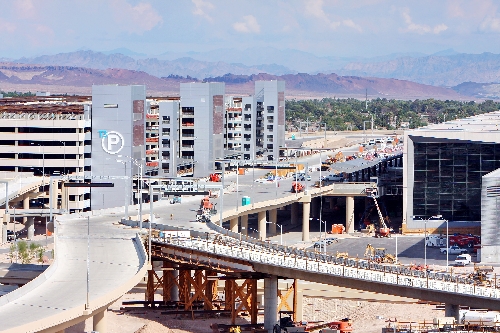Did federal stimulus money deliver for Las Vegas? Opinions vary
As was the case with so many contractors in Las Vegas, the backlog at Cobblestone Construction had shriveled to a scary level last year.
Then the company won a $7.6 million bid to work as general contractor on a new child-care center at Nellis Air Force Base that was funded by federal stimulus money.
"We landed it at a perfect time," project engineer Trish Jackson said. "We didn't have much coming in, but this keeps us pretty busy. It has put a lot of guys that were out of work on the job for at least a while."
But at Las Vegas Paving, listed by the federal government as one of Nevada's top stimulus-work recipients, the word "disappointing" often crops up to describe the program.
"We are grateful for the work we have won, don't get us wrong," said Ryan Mendenhall, a company division manager. "But we are still disappointed because the money that was actually allocated to the state didn't match the hype."
The Nevada Department of Transportation has received $208 million, much of it tagged for the type of road work that has sustained Las Vegas Paving for more than six decades.
"When you divide that among 12 large contractors in the state, it doesn't go very far," Mendenhall said.
The two companies' views reflect the widely diverging opinions of the stimulus program, officially called the American Recovery and Reinvestment Act, a year and a half after it was signed into law. The program was promoted early in the Obama administration as a way to jump-start the economy. But many polls have reflected rising public unhappiness with the stimulus as unemployment has risen.
Through June 30, Nevada had been awarded $2.5 billion in stimulus money and had spent $1.95 billion out of the $862 billion national total. This has led to 9,300 jobs created or preserved by the state's count during the second quarter.
Setting aside the argument over whether "jobs saved" is a valid category, the official stimulus jobs amount to 0.7 percent of the work force. The state's unemployment rate has escalated from 10.5 percent when the stimulus bill passed in February 2009 to 14.4 percent in September; Las Vegas' unemployment rate has jumped from 10.3 percent to 15 percent.
Some early 2009 projections suggested Nevada would gain more than 60,000 jobs from the stimulus. But the job totals have fallen well short, partly because of the nature of the money. Nearly three-fourths funds unemployment benefits, Medicaid payments and existing school programs. Less than 20 percent has gone into the "shovel-ready projects" that were promoted as stimulus' marquee attraction, an amalgam of road projects, renewable-energy installations and public buildings.
"Has stimulus made a difference? Absolutely," said Charles Harvey, the state's American Recovery and Reinvestment Act director. "It has helped any of those who gained employment when they were unemployed."
Danny Thompson, executive secretary treasurer for the state's AFL-CIO, added, "Without the stimulus money right now, this state would be a wasteland. There is this misnomer that the stimulus has somehow failed. But clearly, it has saved or created jobs and had a ripple effect throughout the economy."
But Thomas Cargill, a University of Nevada, Reno economics professor, contends that the stimulus did anything but.
"Anybody familiar with the historic evidence about government attempts to spur the economy would not be surprised that what we have seen this time is minimal impact," Cargill said.
In particular, he said, many of the economic multipliers used to promote the stimulus' effects are inflated and in some cases should actually be zero.
"I am not seeing anything meaningful that says the stimulus has helped Nevada," he said.
The far-flung nature of the grants, from the city of Las Vegas' plan to erect solar panels over parking lots to researching melanoma at the Nevada Cancer Institute, dilutes the impact, Cargill said.
"Scientific research may be very worthwhile, but it grants money to scientists who would probably be employed anyway and for work that may not bear results for years," he said.
At the University of Nevada, Las Vegas' Center for Business and Economic Research conference in June, interim director Mary Riddel raised the prospect of a second stimulus program as concerns about a double-dip recession intensified. However, she advocated "targeted" help to ensure that money went to physical infrastructure projects that would create jobs.
Mendenhall said stimulus-funded work had kept Las Vegas Paving's payroll roughly even, which would have been "very tough" otherwise. However, the stimulus was too meager to justify adding workers.
"The amount of money given to Nevada was so small it didn't help much getting our people out of the (union hiring) halls and getting to work at prevailing wages," he said.
For example, he said a $2 million job kept a crew of 20 busy for two weeks.
ValleyCrest Landscape Development, which has handled hundreds of projects in Las Vegas since opening its office here in 1988, was staring at a bleak order book when it finished with CityCenter late last year. To fill in some of the hole, it successfully bid $2.7 million to landscape the section of U.S. Highway 95 between Martin Luther King and Rainbow boulevards. Interchanges that were formerly dirt are now covered with crushed rock and highlighted by metal sculptures of desert tortoises.
Although the project led to 42 jobs, ValleyCrest President Tom Donnelly said, "Overall, stimulus spending has had a disappointing impact on the blue-collar work force. The whole story line about projects being shovel-ready, we haven't seen that."
The state credited the largest block of stimulus jobs, 5,500, to education programs.
Nevada's job count looks anemic relative to other states due to accounting differences, said Dennis Freimann, a management analyst at the state's American Recovery and Reinvestment Act office. While other places padded their direct hires with projected spinoff jobs, Nevada stuck to only people whose salaries were covered by stimulus money.
Also, he said, people have forgotten that the stimulus contained a tax rebate paid out last year and was always intended to help prop up state budgets that were squeezed by recession. The expectation was that as the economy recovered, rebounding tax revenues and lower social spending would let the states stand on their own again.
This aspect has disenchanted people who might otherwise view stimulus favorably.
"Unquestionably, this has been a positive for a smallish segment of the economy," said Guy Hobbs, president of Hobbs, Ong & Associates, a government finance consultant. "But the biggest chunk of the money has gone into plugging holes in the state budget. This just exacerbates the problems by kicking them down the road."
As a result, the disappearance of stimulus money will confront the next governor and Legislature with the largest deficit in the country by percentage.
"A lot of problems will be coming home to roost in a few months," Hobbs said.
Besides traditional infrastructure, the stimulus targeted energy development and conservation projects. NV Energy, listed by the federal government as easily the largest private sector recipient of money, will spend $137.9 million in stimulus cash on what it terms advanced service delivery.
This involves creating the technological backbone that will link nearly 1.5 million electric and gas meters so the utility can monitor them and, eventually, institute pricing that would vary according to demand and time of day. The advanced service delivery program's total cost is estimated at
$301 million.
Work will continue for a couple of years, but the job count is so far listed at only 24.
A little-known provision changed certain tax laws pertaining to municipal bonds, lowering their cost. The Clark County Aviation Department tapped these bonds, called Build America Bonds, to help refinance the $2.4 billion Terminal 3 at McCarran International Airport. The city used them to pay for the new City Hall rising in downtown.
Although the bonds shaved tens of millions of dollars off financing costs, no jobs have been attached to them because both projects were proceeding without the bonds.
Contact reporter Tim O'Reiley at
toreiley@lvbusinesspress.com or 702-387-5290.
STIMULUS PROJECTS
Nellis Air Force BaseChild Development Center
What it is: On-base day care center covering 26,000 square feet at a cost of $9.7 million. Will accommodate 200 children that had been on a day care waiting list.
Stimulus funding: $7.6 million.
Jobs: 26.
Boulder City Green Building
What it is: A 45,000-square-foot office building designed to house 160 employees for the Bureau of Reclamation now spread over three locations. Designed to meet Leadership in Energy and Environmental Design standards.
Stimulus funding: $11 million.
Jobs: Zero. (Construction not under way as of June 30.)
U.S. Highway 95 landscaping
What it is: Finished certain parcels along the stretch of highway between Martin Luther King and Rainbow boulevards, covering open dirt with crushed rock and erecting sculptures.
Stimulus funding: $2.7 million.
Jobs: 42.
Bonneville Transit Station
What it is: New downtown hub for Regional Transportation Commission bus service, replacing older terminal at a cost of $20.4 million.
Stimulus funding: $5.5 million.
Jobs: 35.
McCarran International Airport Terminal 3
What it is: New $2.4 billion terminal with 14 gates, including six designated for international flights.
Stimulus funding: Nothing direct. Sold a total of $754.3 million in Build America Bonds, created by the stimulus law, which will lower debt costs by nearly $80 million over 30 years.
Jobs: None directly; project was already under way.
Rainbow Boulevard from Smoke Ranch to Craig roads
What it is: Resurface three inches of asphalt on a nearly five-mile stretch and install new sidewalk curb ramps.
Stimulus funding: $1.8 million.
Jobs: Three.
NOTE: Job totals refer to second quarter based on full-time equivalents, not number of people employed. SOURCES: State of Nevada, U.S. Recovery Accountability and Transparency Board, Clark County Department of Aviation.



















